
ELECTRONIC MUSIC AND INSTRUMENTS
By Benjamin F. Miessner
(Miessner Inventions, Inc., Millburn, New Jersey)
Present day commentary by Phil Cirocco (in Green)
Skip down to "Electric Tone Generating Methods" for the interesting items.
Summary—Electronic music and instruments, with
an incubation period of about forty years since their early beginnings,
are now rapidly growing into a final commercial stage. During 1935
retail sales of these new musical instruments exceeded two million
dollars in the United States alone.
This paper presents for the first time in this country a review of
traditional musical instruments, their advantages and limitations,
additional principles which must be considered in creating, and controlling
sounds to make music. The various principles for generating musical
tones and for varying their musical character are described. The historical
development of electronic music instruments are traced, and, the most
important modern instruments are described in some detail.
When we compare music with the other arts, and particularly with other fields of human endeavor, we find tradition enthroned instead of progress. The graphic arts have evolved photography and moving pictures, even in color, and television. The drama has availed itself of every conceivable device to intensify the arts of make-believe. Communication has made tremendously great strides, by telegraph, telephone, and radio. Transportation, likewise, has tremendously accelerated the pace of human movement, with steamships, railroads, automobiles, and airplanes. Illumination today is very far ahead of the oil lamp of the dark ages. Agriculture and industry leave no stone unturned to press improved machinery into service.
But what of music? In this age of progress in every conceivable field, music and musicians still use the traditional implements and machines of hundreds of years ago.
One musician scrapes a horsehair bow across strings of gut, and the
older his instrument is, the more he prizes it. Another blows lividly
through a brass tube or a wooden pipe; another hammers on the drum
of the aborigines. Another, sometimes with terrific physical exertion,
Pounds on a keyboard to rouse his audience through the physical vibrations
of struck strings and huge soundboards through an elaborate system
of levers. Another with aggregations exceeding 10,000 pipes some as
long and large as a forest log, and with hundreds of other complicated
and bulky appurtenances, produces the sounds of the organ.
That most of these have reached the limit of their development is amply supported by their almost fixed design for hundreds of years. The principles upon which they are based, that is mechanicoacoustic, or pneumaticoacoustic, have been carried through these hundreds of years of development, to the end of their capabilities. In what great range of variation these principles have been applied, and for the most part discarded, can be realized by an inspection of the musical instrument departments of such museums as the Metropolitan in New York and the Deutsches in Munich. No radical or important improvements are to be expected from an extension of these old principles.
It is all the less understandable when we consider that other methods of producing musical sounds are available, electrical methods of far greater flexibility and efficiency, implements and machines of infinitely greater capabilities, of lesser complexity, weight, bulk, and cost. Surely the reason does not lie in the few remaining defects of electroacoustic translating devices, as some musicians believe. Violins can and do, even in the hands of the greatest artists, produce the same raucous sounds as overloaded amplifiers or speakers; the mechanical crack of a hammer on a string is surely no sacred part of a piano tone; the truly insuperable problem of keeping 10,000 pipes in tune through the vagaries of temperature and humidity is hardly to be treasured; the ability to vibrate one's lips and blow through a mouthpiece continuously for a whole minute is really not to be cherished as a means of expressing the esthetic art of music.
In this paper we take neither the broadest nor the narrowest definition
within which to confine our discussion. To include all music, and apparatus
useful in producing it, utilizing the technique of electricity generally,
or only the electronic technique involved in vacuum tube apparatus,
we must perforce include such arts as electrophonog-raphy with disk
and films, and even radio broadcasting. We must however narrow our
definition to exclude them, for we are here concerned only with music
made by and with instruments for making music directly, rather than
with those for reproducing or transmitting music already made by conventional
instruments.
We cannot include instruments involving some use of electricity for
then obviously we must discuss such well-known instruments as pipe
organs with electromagnetic valve actions and electric blowers, and
such other conventional instruments, involving mechanical vibrators,
like bells, bars, drums, strings with coupled soundboards, and such
as percussion apparatus of organs with electric action, carillons with electromagnetic hammers, electric player pianos, for these are
only conventional acoustic instruments electrically manipulated. We
must even pass over, with but brief mention, such electromechanical
instruments as the Choralcello, wherein various types of vibrators,
such as strings, bars, and diaphragms, tuned to definite frequencies,
produce the final musical sounds, through the action of synchronized
electromagnetic impulses, set up by interrupted currents, under the
control of key switches. These are acoustic instruments electrically
manipulated and electrically energized.
The Choralcello reached commercial exploitation and production, in
some quantities, about twenty years ago. Its chief difficulty appears
to have resided in inability to maintain accurate resonance between
thousands of tuned mechanicoacoustic vibrators and their periodic,
magnetic driving forces, provided by rotational current interrupters
and electromagnets. As a result these instruments were very difficult
to keep in tune, not because of frequency variations sufficient to
impair temperament, but because of serious upsets in dynamic and timbre
voicing through inexact resonance.
We cannot make our definition so narrow as to include only instruments
wholly electrical in their operation, for there are many with mechanical-electrical
tone generating systems.
We may therefore define an electronic music instrument as a device
for creating music, wherein periodic electric currents are either selectively
generated, or selectively controlled by a player, and translated into
sound. Within these definitive boundaries we will attempt to confine
our discussion.
We are concerned chiefly with methods for generating and controlling
electric currents for use in producing musical sounds. It is not so
important to the player or to the listener how these currents are generated,
but of great importance are the methods provided for their control,
and the nature of the sounds produced. While of no immediate concern
to the listener, the control means must be satisfactory to those who
create music by playing on the instruments; with a playing technique
common to other instruments, such as a keyboard. But the output sounds
must be satisfactory to musician and to listener alike.
There are in existence many types of musical instruments. In our large
orchestras we find those which have proved most useful, and most of
them have serious musical limitations. They may be limited to certain
small ranges of tone frequency, or power, or timbre, or by their inability
to sound more than one tone at a time, or their inability to change
their tonal characteristics at the will of the player.
The cymbals, for example, while an important part of every large orchestra,
can only emit sounds of a certain noisy character at stronger or weaker
power at a constant pitch. The triangle produces a more musical sound
but is otherwise just as limited as the cymbals. These, like the kettle
drums, can hardly be considered as musical instruments, for one cannot
truly make music on them. They are to music what exclamation points
or other punctuation devices are to the written word—tremendously
effective but seriously limited. The flute can make music alone, but
has great limitations as to frequency, and power, and timbre. While
its importance in an orchestral assemblage is undisputed, one would
hardly care to listen to an entire concert played on a flute, or, worse
still, a concert of flutes, as Helmholz long ago observed!
Proceeding to the brass, wood wind, and string instruments, there is
a progressive increase in musical utility. In the piano and organ,
however, we find the greatest usefulness, because of their large range
of pitch and power and timbre, and particularly their ability to produce
many tones simultaneously. Where other instruments produce only simple
melody, these can, in addition, produce very complicated harmonies.
Large organs, especially, provide the maximum range and complexity
of musical expression for a single performer.
The organ has a tremendous advantage over the piano in its timbre-variable
performance; the piano, in which tone timbre cannot be dissociated
from tone power, has, however, the ability to control the power of
individual tones by the force of the fingers on individual keys. Also
its tones change constantly in timbre from beginning to end. It has
therefore a tremendous incisiveness and vitality due to dynamic nuances.
The important point here is that the usefulness of a musical instrument
resides in its versatility. The wider its range of performance, in
pitch, in power, in timbre, and in other characteristics, the more
useful does it become. The closer an individual performer can come
to the effects of an orchestra the more impressive and satisfying will
his performance become.
We, as scientific workers, may here well inquire as to what constitutes
the musician's basis for a satisfactory musical instrument. One of
our foremost musicians, Leopold Stokowski, has given us one such basis.
He emphasized the need for providing "any desired timbres and
for new timbres; for creating any frequency, any duration, any intensity,
any combination of counterpoint, of harmony, of rhythm." We
must, if we are completely to satisfy the musician, provide an instrument
which will permit him to produce all the known and useful musical effects,
and preferably also unknown but useful effects. If this requirement
be too comprehensive then we must provide as many effects as possible,
the limiting factors being cost, bulk, weight, and even the human limitations
for controlling its performance.
In the language of electroacoustics, we must provide wide ranges of
frequency, of amplitude, of harmonic composition; these are the conventional
parameters of musical sounds. Here it seems necessary to define partial,
harmonic, inharmonic partial, component, and overtone, as there is
much confusion among musicians on the one hand and physicists on the
other relative to their meaning. By partial I mean any single frequency
part of a complex tone; by harmonic, any partial falling in a Fourier
series of integrally related partials; by inharmonic partial, any single
frequency partial which does not fall in such a Fourier series; by
overtone, any partial above the fundamental in frequency; usually the
first overtone is the second partial of a Fourier series, but it may,
as in bell tones, be inharmonic also; by component, any part of a complex
tone; it may be a harmonic or inharmonic partial of discrete frequency,
or it may also be a transient or a noise comprising a band of frequencies,
such as that set up by the crack of a felt hammer on a piano string,
or the noise of escaping air made when a flute is blown, or the scrape
of a bow on a string.
There is another important but generally unrecognized characteristic
of musical sound, determined by the shape of the dynamic envelope of
the tone. A tone of given amplitude, pitch, and harmonic composition
may produce very different auditory effects due alone to the manner
in which it starts and stops, even without transients. It will vary
also with the rate of rise or decay.
The tones of a stretched string will vary markedly with the manner
of excitation, as for example, by plucking, striking, and bowing, and
this leads us to the tonal differences caused by transients, which
are set up by such exciting devices. With continuous tones these may
occur only at the moments of starting or stopping. With damped vibrations,
produced by such generators as struck or plucked strings, the harmonic
composition changes constantly during the progress of the tone from
beginning to end, and its average character changes markedly with its
initial amplitude. Obviously such a tone cannot be completely described
by giving its fundamental pitch, its amplitude, and its harmonic composition.
We must specify the envelope of every component, harmonic or inharmonic,
and include incidental noises as well.
There exists again a great deal of confusion among musicians and physicists
on this point. We are accustomed to see spectral analyses of tones
and sound. These may specify the exact frequencies of all harmonic
components and their relative amplitudes; sometimes they include also
inharmonic, definite-frequency components, and, only very seldom, also
the continuous-frequency components of transients and noises. Obviously
these spectral analyses can only hold good for a tone that has reached
and continues in a steady state; during the starting and stopping periods
practically all tones have a variable composition. A great many tones
of the damped type vary constantly from beginning to end, so that it
is quite impossible to describe them by a single analysis. A series
of analyses, at different points along their time course, like a series
of pictures of moving objects, must be used, or better still, we must
provide a time-amplitude graph for each separate component of the complex
sound. This is the only way of giving a comprehensive, objective description
of a complex tone. A subjective description would involve also other
factors determined by the limitations of the ear.
Again a tone of some constant and complex harmonic composition, will
sound differently to the ear at differing fundamental pitch. If this
be one thousand cycles, we may hear harmonics say up to the twentieth,
but if it be 5000 cycles, we may hear them only up to the third or
fourth. Variation of tone amplitude may also cause variations of harmonic
composition as heard; harmonics below the audible threshold at low
amplitudes may rise above it at high amplitudes. Again at high amplitudes
the subjective pitch may be higher or lower than at low amplitudes.
These are some of the more important parameters of musical tones which
we must consider in our electronic apparatus.
The mechanism or methods for the control of these parameters by a musician
is also very important. While it may be that new methods of control
might eventually prove to be better than the traditional methods, it
is likely that faster progress will be made in electronic music with
instruments utilizing playing techniques already mastered by most musicians.
In the keyboard instruments we find the easiest and, while not the most complete, perhaps the best control. Individual tones can be started and also stopped at will. The desired pitches are all predetermined and set; the timbres are also predetermined; off-pitch playing is not possible, unless the wrong key is struck, nor are unmusical single tone qualities possible. In these instruments, and particularly in the large organs, the physical limitations of the player are fully or almost fully reached. Both hands and both feet are worked to their utmost for manipulation of the various controls; such instruments can produce tremendously intricate patterns involving very complicated melodies, harmonies, rhythms, timbres, and other characteristics of music.
Electric Tone Generating Methods
The generation of tone representing currents for electronic music may be accomplished by a great variety of methods and apparatus. Any device for producing modulated or interrupted direct current, or any device for producing alternating currents may be more or less useful. These may be produced by rotary, vibratory, or other types of mechanically moving devices, by purely electrical devices, or by acoustic devices. In fact any device for producing any type of audio-frequency periodic motion may be so utilized if appropriate means are provided for translating the motion into periodic voltages or currents.
The writer has prepared a rather extended list of tone generator types and useful principles. These have been classified into five groups as follows: 1. Pure electrical; 2. rotary scanning devices; 3. vibratory mechanicoelectric; 4. acoustic electric; and 5. hybrid combinations of 1, 2, 3, and 4. These four classified groups are shown in Tables I, II, III, and IV. These groups are quite comprehensive but make no pretense of completeness.
TABLE 1
Pure Electrical
(a) Oscillating arcs or any device with negative resistance characteristics
such as dynatrons, crystal contacts, etc.
(b) Relaxation oscillators
(c) Vacuum tube with feedback
(d) Thyratron oscillator
(e) Condenser-inductance discharge
(f) Magnetostriction oscillators
(g) Radio-frequency beat systems(h) Electrolytic
TABLE II
Rotary (Scanning Devices)
Variable area, distance, impedance, or intensity
(a) Magnetoelectric: generators, modulators, etc.
(b) Electrostatic: generators, modulators, etc.
(c) Photoelectric
(d) Acoustic siren
(e) Phonographic: mechanicoacoustic electric, mechanicomagnetoelectric,
mechani-coelectrostatic photoelectric, magnetoelectric, mechanicopiezoelectric,
etc.
(f) Impedance contact interrupters and modulators
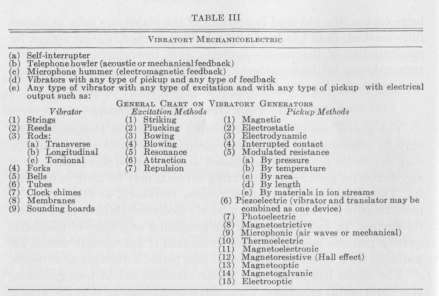
TABLE IV - Any Type of Acoustic Vibrator and Any Type of Acoustic Electric (Microphonic) Device
(a) Pipes or horns
(b) Reed pipes
(c) Sounding boards variously driven
(d) Membranes
(e) Bells, bars, strings, tubes, reeds, forks, chimes, and other sounding bodies
For control of harmonic composition of the output sounds there are available in general several distinct methods. These are listed in Table V.
Timbre Control Methods
In addition to means for generating currents for use in electronic instruments, we must provide methods and apparatus for their satisfactory control, not only for switching them on and off of amplifying and reproducing apparatus, but, more particularly, for timbre or tone quality control.
TABLE V
Timbre Control Methods
(1) Synthesis; adding together pure or relatively pure desired partials
(2) Separation; subtracting undesired partials from a source very rich in partials
(3) Multiple quality generation; using a separate complex-wave generator for
each desired timbre, and mixtures of these.
(4) Formants
(5) Frequency-amplification control
(6) Envelope control
Let us examine these various methods.
(1) The Synthesis Method
In the synthesis method we generate separately the various current frequencies required for fundamentals and overtones (ordinarily harmonic) of all the tones of the musical scale in whatever range is desired, both as to fundamental pitch and number of partials for each separate pitch. Over each of these partial tone currents we provide amplitude control, so that we may introduce any partial generated, in any desired amplitude, into the output tone; if inharmonic, definite-frequency partials or bands of continuous-frequency noises are desired, these may also be generated and controlled in amplitude. The controls preferably should be so unified that one device mechanically, somewhat as in unicontrol radio receivers, controls particular numbered partials for the whole range of fundamental pitches on a given keyboard or other playing pitch control arrangement. This is necessary to preserve constant timbre throughout a given fundamental pitch range. If several different keyboards are used, separate sets of partial controls for each keyboard are necessary in order that they may play with different output tone qualities.
(2) The Separation Method
This is the reverse of the synthesis method, since with it, we generate, for each desired fundamental frequency, a complex wave having in it all the partials that may be desired. Then, by a process of subtraction, we take out of this complex wave all of those partials not desired in the output tone, and leave those which are desired in the correct amplitudes.
For example, with a beat system, we may generate by radio-frequency vacuum tube oscillators (one for each desired fundamental output pitch) complex oscillations of different fundamental frequencies; the outputs of these oscillators are controlled by keyboard switches (one for each oscillator) and thereafter combined in a beat circuit, with the output of a fixed, complex-wave oscillator operating at a neighboring fundamental radio frequency. This oscillator is provided with a separate amplitude control, such as a tuned band-pass filter, for each of its partials. The carrier and summation frequencies are filtered out, and the difference frequencies, after rectification, are preserved for reproduction. The essential feature here is that but one control device for each partial of the fixed frequency oscillator determines the amplitude of each corresponding partial of the audio-frequency output current throughout its whole fundamental pitch range.
Here, the writer describes what we now know as additive and subtractive synthesis.If we go by Miessners definition, we are all playing "electronic music separators" not synthesizers.
Synthesizers, as defined by Miessner, would encompass instruments like the DX-7, the Hammond organ, the Tellhamonium and other additive synthesis devices.
a. Audio-Frequency FiltersVery frequently it is suggested that audio-frequency filters be used for timbre control, but this is extremely impracticable and complicated. Suppose, for example, we have an instrument, like the piano, of 88 separate pitches, and suppose we wish to provide control only up to the tenth partials of those pitches. Theoretically we must then provide ten times 88 or 880 filters, starting at about twenty-seven cycles. If we provide no filters above say 15,000 cycles, we will still require several hundred of them. Furthermore, all filters for like-numbered partials of all 88 fundamental frequencies must be ganged mechanically together to provide a workable control, and thus ten gangs of filters would be required, one for each of the ten partials. Realizing the amount of material required for such a scheme, we can readily understand its impracticability. The radio-frequency beat system, however, is practical because it involves only one radio-frequency filter for each controlled partial, and with ten partials only ten niters in all are required. However there are serious problems involved in providing 88 sources of stable radio-frequency oscillations without undue cost and complexity.
Here, Miessner concludes that audio filters are not pratical for use in an electronic musical insrument. This was probably true in 1936, but only 2 years later, The Hammond company utilized 72 (ganged switchable) audio filters in the Novachord.
(3) Multiple Quality Generation
In this system a separate series of generators of fixed complex-wave forms is provided for each desired timbre. Thus, if we have say 88 distinct pitches, we provide one generator for each pitch, and all in this series have the same harmonic composition. If we wish ten different harmonic compositions we must provide ten such sets of generators, or a total of 880 generators. This is the plan utilized in pipe organs where the individual generators consist of wind-blown organ pipes of differing output tone quality. Obviously mixtures of two of more of the generator outputs may be used, either at the same fundamental frequencies or of harmonically related fundamental frequencies, to extend greatly the timbre range.
In the pipe organ no attempt is made to control the amplitude of individual generator outputs so combined, as this involves great difficulties, especially in voicing; it is necessary therefore to use large numbers of pipes, sometimes aggregating 50,000 to provide a very large range of timbres. With electrical generators such control is simple, and the ability to regulate the contributions of the various definite timbre generators to a mixture is very important as a means of greatly extending the timbre range with relatively few generators.
If the various complex-wave generators of the same fundamental frequency, or of exactly harmonically related frequencies, are so rigidly coupled together as to provide continuously fixed phase relationships between their like frequency partials, it is possible to extend further the timbre variation by phase reversal control, in addition to amplitude control, of their outputs. By this means the components of one generator may be made to add to, or subtract from, like frequency components of another or others and, by amplitude control, in desired degrees. For example, one generator with strong lower and weak higher partials may be combined with another of reverse type. With extreme aiding phase adjustment a new harmonic composition, with strong low and also strong high components, is produced; with extreme opposing phase adjustment another new harmonic composition results, perhaps with no higher partials at all. With intermediate amplitude adjustments many other harmonic compositions result.
(4) Formants
An interesting type of timbre control has been developed in Germany, based on the theory of Hermann relating to the timbre of vocal sounds. According to Hermann the vocal timbres are formed in the throat, mouth, and nasal cavities, by steep wave-front transients caused by the opening and shutting of the vocal cords at the frequency of the fundamental vocal pitch. These explosive like interruptions of the air stream from the lungs shock the several coupled acoustic resonators of the vocal system into damped oscillations, which may be inharmonic to the frequency of the vocal cords. Hermann introduced the term "formants" to designate these effects.
Obviously the timbre of the vocal sounds, as in vowels, changes with the shape and volume of these coupled, impulse excited, and rapidly damped resonators, as controlled by the tongue, the soft palate, the mouth, and so forth. Similarly, any externally coupled air cavity, such as cupped hands held before the mouth, or a coupled tubular or conical air column such as a megaphone, very materially alter the vocal timbre. The timbre modifying effects of diaphragms, horns, and other coupled, strong damped vibrators, particularly when of high frequency, on the performance of loud speakers is well known, and these effects are many times due to formants. If these coupled vibrators are not strongly damped, they have, in addition, another effect, caused by resonance with, or forced vibration by, some component of the driving force.
The formants always decline in amplitude during a fundamental oscillation period, and may even stop before the end of this period due to their rapid damping, or they are extinguished with the start of the next cycle. They usually comprise a band of frequencies, high compared to the fundamental, but this band does not move up and down with the fundamental frequency. If the fundamental frequency rises above the lower frequency border of the formant frequency band, the lowest of the formant frequencies disappears, since the damped resonator which supplied it is no longer excited by the fundamental.
The principles of formants are not actually inconsistent with conventional theory. The changes they introduce are always within the fundamental frequency cycle, and they recur regularly with every such cycle. Therefore they constitute true Fourier components, the harmonics introduced by them always having integral frequency relationships with the fundamental.
With particular types of electrical tone generators, such as relaxation oscillators, and with amplifying circuits, provided with oscillatory portions of regulable frequencies and rates of damping, for-mants may be introduced and controlled so that they provide a very simple and important means of governing tone quality. They are most useful with instruments having a restricted pitch range, of the order of two or three octaves, where the formant frequency range is not too far removed in frequency from the fundamental pitch. The use of formants in instruments of wide pitch range such as pianos and organs, or in instruments designed for chordal performance is of questionable value.
(5) Frequency Amplification Control
Another important timbre control method is one, based, not on particular partials, but on absolute frequencies, like tone controls of radio receivers. Such a control, while affecting the voicing, or sound power output between low and high frequencies in instruments of wide frequency range, is nevertheless a very useful one for timbre variation applicable very simply in the electroacoustic translating system.
(6) Envelope Control
We have previously discussed in some detail the effect of varying the shape of the envelope of a tone. While this type of control is not truly a timbre control, as that has to do with variations of the wave form of recurring fundamental frequency cycles, and as envelope control has to do with the envelope shape of a train of such waves, nevertheless we include it since broadly it does affect the character of the tone. Further, the writer has pointed out the desirability of means and controls therefore, which would enable us to give the desired envelope shape to each and every partial of a complex tone, whether definite frequency harmonics or definite frequency inharmonics, or continuous bands of noises. Only by such envelope control, added to generators for producing all desired components, can we ever produce every known or conceivable sound.
The Choir Effect
In addition to the previously discussed arrangements for control of tone timbre or, more broadly, of tone character, there is another type of control important especially to those desiring duplication of pipe organ performance. This is the so-called "choir" effect; i.e., the sound effects of several independent sources tuned, as well as possible, to the same frequency, and having the same or different qualities. It is never obtainable where absolutely fixed phase relationships are found. In the pipe organ, when mixture stops are used, a new, single tone quality does not result, but rather a mixture of qualities definitely discernible, is the result. This is due to the fact that the tuning can never be so perfect that fixed phase relationships exist between all like numbered partials, and these random and continuously changing phase relationships, with resulting irregular beats, serve to keep each of the individual systems of partials, having fixed phase relationships among them, separate and apart from other systems (of the other tones in the mixture) and identifiable by the ear as individual systems. The result is that the ear hears several separate tones of different quality mixed together; i.e., sounding at the same time, as, for example, a violin, an oboe, and a trumpet, all sounding the same fundamental frequency. If, however, all the frequencies involved in these three sounds were produced by one generator, they would sound like one new sound instead of the three sounds mixed together.
Another example is as follows: If ten violins sound one note together, as in an orchestra, the ear hears something quite different from one violin amplified to the same loudness, or say from ten synthetic violin tone generators all producing exactly the same pitch, and with some fixed phase relationship between them. In the first case the combination tone (of all ten) is continuously varying, due to inexact or changing partial frequencies; in the latter the tone spectrum would be monotonously constant, having none of those rapid variations. I think the effect of several instruments in choir or chorus could never be produced by mechanical sources such as generators running at constant speed, certainly not with generators rigidly coupled together to Prevent any possible phase shift.
With separate generators, or with generators (like rotors) having considerable inertia and running at constant, though slightly different speeds, so as to produce slight differences in like partial frequencies in the several tones, no true choir effect could be produced either, as the beats between like partials, slightly different in frequency, would be of steady fixed periodicity, and the tone would still sound mechanical and monotonous.
Another important point here is that in the organ, orchestra, and other groups of tone sources, the tuning of these separate sources to the tempered scale frequencies is never exact, and the variations from exact tuning are random. The result of this is that, in changing from one pitch to another, the beats between the generators have different frequencies for every pitch.
With pipe organs, orchestras, etc., the separate sounds proceed to the listener from different sources in different positions in space, so that their sounds traverse different distances, and produce different interference patterns in places where reflections can occur.
Therefore if several like generators of fixed phase relationship or with some constant and small difference in fundamental frequency be sounded through separate loud-speakers spacially separated from one another, this might aid in producing the illusion of several wholly independent instruments of different timbre sounding together.
Much of this discussion on the choir effect is speculative and without conclusive experimental evidence. It is included as an important subject wanting a good deal more illumination by facts.
Historical Development of Electronic Instruments
While it would be desirable to present a complete review of all the various developments in this art, as shown in its literature, this is utterly impossible in view of its already great extent.
My collection of published literature on this subject numbers thousands of items. There are in it, for example, over 350 United States Patents relating specifically to, or bordering on, electronic musical instruments; also foreign patents numbering about 200; published applications for foreign patents numbering several hundreds more; there are about 150 technical and semi technical papers and descriptive articles, while popular articles, advertisements, etc., number in the thousands. There are also three books; a very comprehensive and technical one of 200 pages in German, "Electrische Musik," by P. Lertes, published in 1933, which includes a bibliography of 376 items, and two others, published in 1930, and of lesser scope, "Electrische Musik," by Dr.-Eng. Friederich Trautwein, and "Das Trautoniumr by Joachim Winckelmann.
To digest and present a review of this great mass of information is completely beyond the scope and space allowable for this paper. A selected bibliography, is appended to this paper, for the use of those who may be especially interested in it.
The growth of the art as represented by patents, technical literature popular articles, and commercial projects is presented in Fig. 1.
I shall attempt to make a selection of significant developments and instruments to act as guideposts for those seeking the course of progress of this art, and to point out what seem to be its most representative examples. Obviously a great many equally important developments cannot be here included. Of those treated here, only the important features can be described.
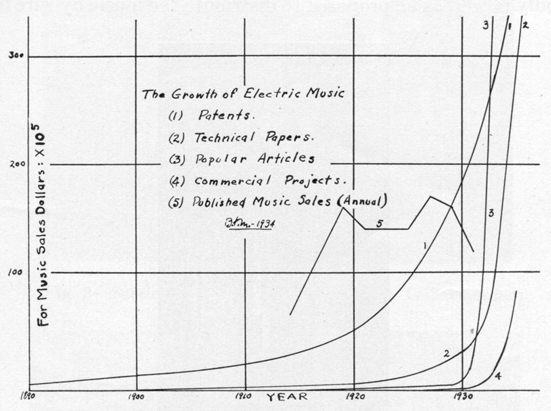
In tracing this history, I find at the outset, that instruments have
developed chiefly along three lines, namely rotating electric, pure
electric, and mechanicoelectric.
Rotating Electric Instruments
The Telharmonium
Probably the earliest and most important of all the early schemes for making music electrically were those proposed and used by the American, Thaddeus Cahill, in his Telharmonium. His five voluminous patents comprise 322 pages altogether.
In Cahills patents lie the broad foundation stones of all the rotating generator, synthetic timbre control instruments. He had a truly amazing and profound knowledge of the principles of this art that he was founding over thirty-five years ago. Nearly all that is fundamentally important today in instruments of this type, Cahill understood and utilized.
His Telharmonium consisted of a series of alternators of relatively pure wave form, and with definite frequencies of the musical scale. Timbre mixing switches permitted combining, for any one complex tone, harmonic components obtained from his generator sources. Keyboard master switches connected and disconnected the alternators so combined to and from telephone reproducers. His generators were of goodly power, as he proposed to distribute the music by wire to sub-

Fig. 2—Cahill magnetoelectric tone generator unit comprising
fundamental and seven overtones.
scribers. He lacked the amplifiers we now may use with alternators
of minute size and power, and this is the chief difference between
his apparatus and present-day instruments employing rotating magneto-electric
generators. In his patents he shows, by hundreds of drawings, the various
details of his inventions, such as interrupters and generators, with
belt and gear-driving arrangements, frequency-stabilizing devices,
timbre mixing systems, volume control, etc. His apparatus was actually
built in Holyoke, Massachusetts, and transported to New York City where
it was set up and operated. It comprised over thirty carloads of equipment.
Cahill showed arrangements for producing all exactly harmonic components
of complex tones up to the sixteenth, using separate alternators for
each, and with the amplitude of each
regulable by timbre mixing stop switches. He showed also simplified
arrangements whereby these partials could be obtained from fewer generators.
Additionally he showed still simpler means for obtaining his partials, with some sacrifices in exact harmony between them, by taking all of them from one series of
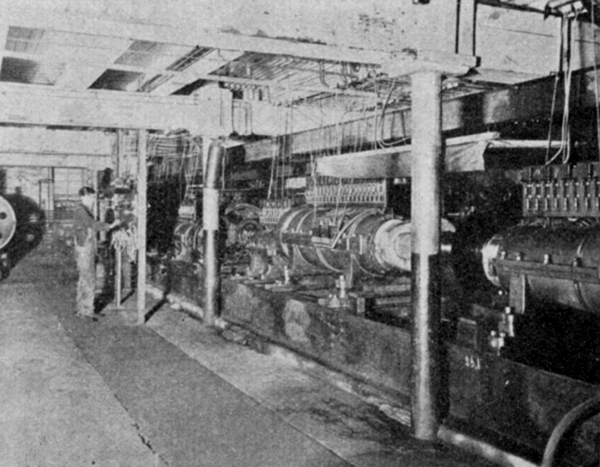
Fig. 3—Section of a generator room of the Telharmonium.
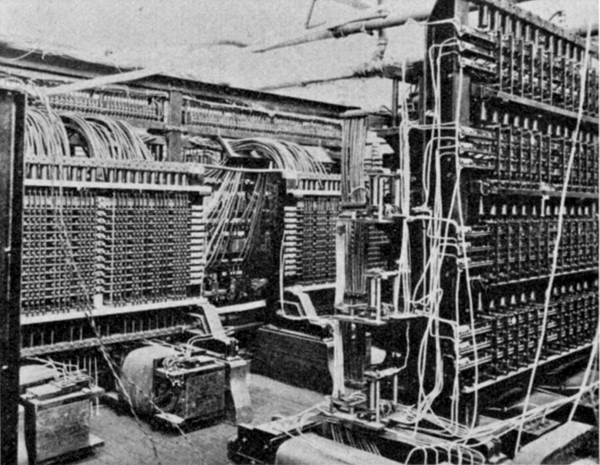
Fig. 4—Telharmonium. Close-up view of wiring.
alternators driven by one motor,with frequencies closely approximating
those of the tempered scale. In his patent No. 1,213,804, he says
of this arrangement: "The approximate
third, sixth, and twelfth harmonics, although varying by only a little
more than one tenth of one per cent from true third, sixth, and twelfth
harmonics I find to be much inferior to the corresponding true harmonics—so
much inferior, that they ought not, in general, to be substituted for
them." He had full appreciation of such difficulties as resonance
in reproducing devices, which he overcame by proper voicing of the
individual generator outputs. He even shows and explains means for
securing a touch-responsive expression control, and for varying the
output tone amplitudes of individual tones by variable pressure on
individual keys of his playing keyboard. He points out the disadvantages
of rectangular tone envelopes which this arrangement avoids.
In Figs. 2, 3, and 4, are presented some views of his apparatus. This electric music distribution system failed commercially because it was found to interfere seriously with telephone service due to induction.

Fig. 5—Ranger organ.
The Ranger Electronic Organ
In June, 1931, Captain Richard H. Ranger made the first public demonstration of his pipeless organ at Newark, New Jersey.
Ranger's apparatus consisted essentially of twelve separate sets of motor-driven alternators precisely maintained at given rotational speeds, by tuning-fork control apparatus. One of these sets of alternators, as shown in Fig. 5, generated all the required C's; another all the C sharps; another the D's, and so forth. From these alternators he obtained all the desired fundamentals and their true harmonic frequencies for the tempered scale. Timbre control switches selected the partials and their amplitudes for any desired tone quality. Amplifiers were, of course, used with reproducers to translate the feeble audio currents into sound.
Ranger's improvements over the basic work of Cahill were made possible
by the advent of the vacuum tube. For example, he provides means for
automatic selection of different amplifiers, for different simultaneously
produced tones, to prevent cross modulation in a single amplifier;
means for avoiding keying transients, for accentuating high or low
frequencies, for restricting tremolo to specific components of a complex
tone, and at different tremolo rates, means to provide glissando effects,
for regulating the temperament, for providing damped wave trains in
simulation of percussive tones, and numerous other details.
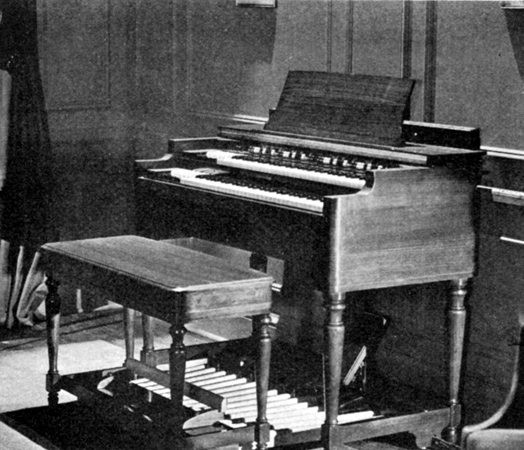
Fig. 6—Hammond organ, complete except for power amplifier reproducer
cabinet.
The Hammond Organ
Again following the basic principle of the Telharmonium, Laurens Hammond has developed an electronic organ. In Figs. 6 and 7 are shown some of the details of this instrument.
In this instrument a synchronous
motor drives a series of 91 tone generators of diminutive size through
gears and pinions. These generators
have frequencies exactly at or near those of the tempered scale. The
amount of agreement and departure from this tempered scale of frequencies
found in the Hammond organ have been listed in his patent No. 1,956,350.
For the sake of simplification the partials for complex tones are
all obtained from this series of alternators. There
is some sacrifice in the precision or exactness of harmony between
some of the partials due to this simplification, but this is hardly
noticeable.
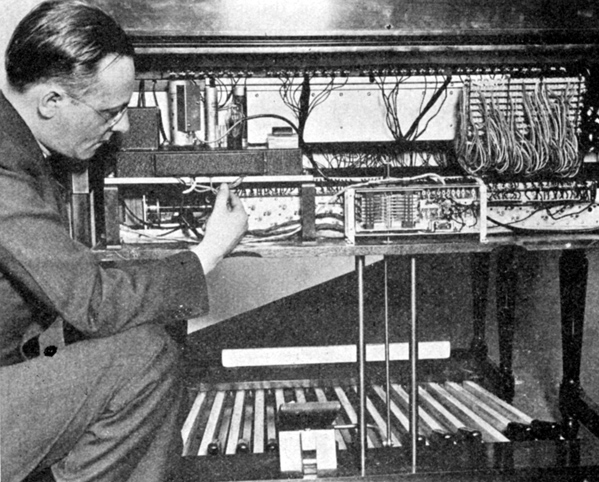
Fig. 7—Hammond organ. Internal view with back of console removed.
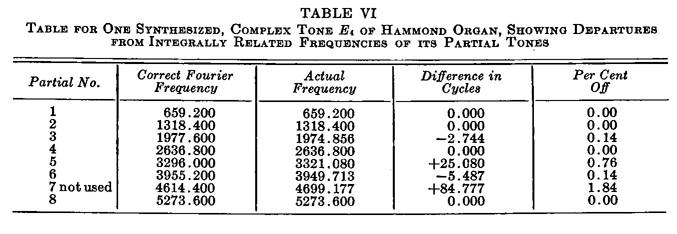
In Table VI there are shown a series of eight partials based on a fundamental of 659.2 cycles per second; that is, EA in the musical scale, taken from the table in the above-mentioned patent. It is seen that the first, second fourth, and eighth partials are exactly in tune with each other as they are all exactly integral multiples of the fundamental. However the third, fifth, and sixth partials are somewhat out of tune. The instrument provides no means for introducing any seventh partials. All the individual alternators except the twelve highest ones, give sine wave outputs as nearly as possible. Condensers are used in parallel to suppress their low amplitude harmonics. The twelve highest frequency alternators produce rather complex wave forms so that considerably higher frequencies than those indicated in the table are produced, when these are in the circuit.
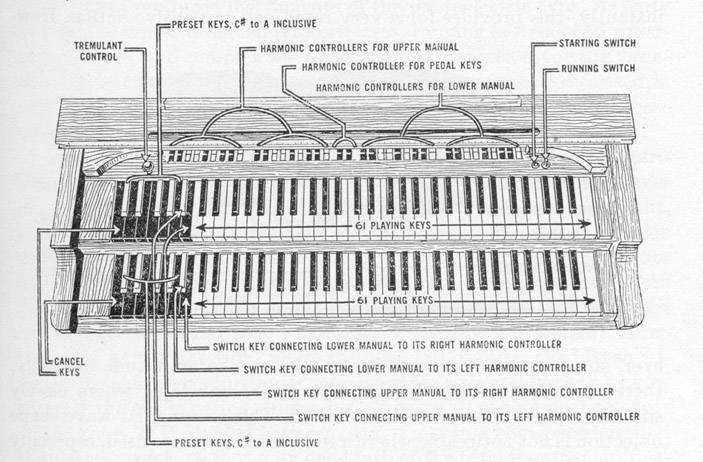
The harmonic controls for each manual provide amplitude regulation for a series including the first, second, third, fourth, fifth, sixth, and eighth partials. In addition to these, sub fundamental and sub-third harmonic controls are provided, making nine components altogether, which can be mixed together in any desired amplitude ratios, as shown in Fig. 8.
Nine pre selected timbre keys or "stops" are provided for
each manual, or eighteen in all. In addition, five groups of harmonic
controls are provided, two for each manual and one for the pedal keyboard.
Each manual group has nine drawbars (Fig. 9), while the pedal as four,
controlling the voltage of each partial tone of any mixture,
and each drawbar has nine different positions in logarithmic amplitude
steps. The partials controlled by the manual drawbars are, subfunda-mental,
subthird, harmonic, fundamental, second harmonic, third, fourth, fifth,
sixth, and eighth harmonics.
There are thus twenty-three timbre mixtures instantly available, eighteen of which are set by internal adjustments, and five of which may be changed at will. The eighteen internally adjusted mixtures may also be altered, if desired, by changing internal connections.
The keyboard keys operate nine-pole switches, one for each component selected by the timbre mixing system. These switches produce output tone envelopes of rectangular shape. Since the tone thus starts instantly, this provides for a very rapid and responsive action. How-
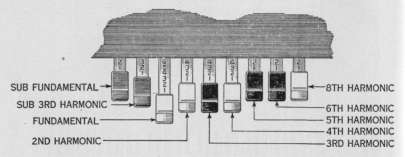
Fig. 9—Arrangement of harmonic controls for the Hammond organ.
ever, since organ pipe tones do not come up to amplitude instantly,
there is a disadvantage in this rectangular envelope, where closely
simulated pipe organ effects are desired. This rectangular wave shape
objection is not noticeable where a reverberant room is used, especially
if the auditor be at some distance from the reproducer, due to the
time required for the building up and decay of sound in the room. In
a reverberant room this may compensate for the abruptness of starting
and stopping of the tone at the source. But, if the room is strongly
absorptive, the rectangular envelope may give a disagreeable character
to the tone.
The instrument is also provided with swell-pedal volume control, and an adjustable tremulant device usable at will. The regular amplifier is rated at thirty watts, with 0.5 per cent harmonic distortion, and feeds two Jensen reproducers. For increased tone power, additional standard power amplifiers with reproducers are added in parallel.
In spite of the theoretical objections discussed, the Hammond organ
is of very fine design and construction in every respect, and it is
a truly
remarkable commercial instrument of moderate cost and widely accepted
musical capabilities.
Photoelectric Rotating Generators
Photoelectric organs, depending in general on an optical counterpart of the acoustic siren, developed in 1799, have been known since 1888 when Mercadier used a rotating light interrupter and light sensitive cell as a source of alternating current for multiplex telegraphy.12 Since 1916 H. J. van der Bijl,13 Hugoniot,14 Potter,15 Toulon,16 Spiel-mann,17 Goldthwaite and Hardy,18 Lesti,19 and Eremeeff,20 among others, have produced instruments of the photoelectric type. As early as 1922 the writer designed photoelectric scanning systems and generators for pure and complex waves, actual or synthetic, involving varia-able intensity, variable area, and line wave records, and disclosed in 1926 in a patent application, a musical instrument involving these principles.
In the Hardy-Goldthwaite organ, photographic disks bearing variable area or variable density waves translated from recorded waves of original instrumental sound, rotate between a light, an optical slit, and a photocell, thus producing output currents of various definite timbres. Interesting here, in obtaining the tempered scale frequencies on a single disk, is the manner of avoiding rotational-frequency clicks due to sudden phase shifts at the joining point between beginning and end of a given circular tone wave track, (possibly 360 degrees). However only half of the total phase shift, or 180 degrees, need be so adjusted for since the adjustment may be either a shortening or a lengthening of the cyclic period. Instead of allowing all of this shift to occur at one point, it is divided between, say, ten points equispaced around the circular track, so that only one tenth of the total required shift occurs suddenly at any one point.
On each tone wave disk are recorded photographically the frequencies of the tempered scale for a pitch range of 71 notes, all for a given tone quality. Separate disks are used for each separate tone quality; also, of course, mixtures of two or more of these tones can be used. The keyboard keys operate shutters, either by direct lever action or through a torque amplifier.
Mercadier, Goldthwaite-Hardy, Eremeeff, and others have also utilized sine wave records for synthesizing desired timbres according to the principle of Cahill.
Another interesting arrangement is that used by Lesti and Sammis in the Polytone. Here, instead of using a series of similar wave-form cycles on a continuous track, with a single scanning device, only one complete such cycle is used with periodic scanning by a series of similar scanning slits, equispaced on a continuous track. The slit spacing is precisely equal to the wave-form lengths, so that this wave form is repeated at the scanning frequency; i.e., the number of slits passing it per second. The same method was disclosed as early as 1921 by the French inventor Hugoniot, who described an electrical musical instrument of this type in his patent.
With this scheme the various types of wave forms for different timbres may be placed in radial sectors on a disk; another disk carrying the scanning slits in circular tracks rotates before this wave-form disk. A source of light and photocell complete the translating arrangements. Each slit track scans its corresponding wave cycle at a speed corresponding to one pitch of an approximate tempered scale. Thus, one wave and one slit track serve for each tone frequency of the tempered scale. Naturally the lowest pitch tracks are nearest the center and the highest are nearest the circumference of the scanning disk.
The wave-form cycles of different timbres are placed in different sectors on the wave-form disk. Any one of these timbres may be reproduced by rotating the wave-form disk to the fixed operating position between lights and photocell. A radial row of lights or shutters under keyboard control, one for each scanning track, enables one to reproduce a given wave form or timbre at any one of the scanning frequencies of its musical scale. If several rows of lights are used it is possible to reproduce several recorded wave timbres simultaneously as mixtures, or by different keyboards.
One difficulty with photoelectric generators is noted. When, as in most cases, numerous electric lamps are used, and operated from an alternating-current outlet, there is a very real problem in getting a steady light without modulations twice the exciting frequency or 120 cycles. Batteries are objectionable, and a rectifier-filter outfit providing sufficient steady current for dozens of lamps becomes cumbersome and expensive. The light itself must have no modulations, as these produce fixed tones, mixed with the recorded tones. Also the required high intensity lamps frequently burn out.
It is of interest here to note that, with these rotational generators, only frequencies at integral multiples of the rotational speed can be produced unless there is some special provision like, in effect, that of Hardy and Goldthwaite.
The tempered musical scale of frequencies progresses from one note to the next by a ratio of the twelfth root of two. Obviously a series of rotational generators driven by one motor cannot produce such frequency ratios. These ratios can be more and more closely approximated as the rotational speed is reduced, and as the number of cycles per revolution is increased. But, for the exact tempered scale of frequencies desired by musicians, particularly when playing with other instruments, some means, in addition, is necessary. Hardy's method is one solution; Eremeeff has shown another method, utilizing, instead of a rotary scanning device, a very long film strip scanner capable, like a motion picture film, of running an hour or so.
Cahill and Ranger avoid this difficulty by using twelve separately driven groups of generators, one for each of the pitches of the tempered scale of one octave; since all the other desired frequencies are merely integral multiples, that is, octaves, of these frequencies, their tempered scales are complete and exact. Hammond, however, has all his generators geared together and driven by one motor. This simplifies matters greatly but leaves the disadvantages of a scale of frequencies not strictly in accord with that used universally in other musical instruments.
Rotating Variable Capacity Instruments
A number of inventors have suggested the use of rotating condenser types of generators for use in electrical organs, but, so far as is known to me, these schemes have not been developed very far; however they hold considerable promise.
Pure Electronic Instruments
Probably the first to produce musical tones by pure electrical means
was Duddell who, in 1899, utilized a direct-current arc, shunted by
an inductance and condenser. Since that time numerous arrangements
have been proposed for pure electrical musical instruments. These,
like Duddells arc, are based on generator devices with negative resistance
characteristics, such as gaseous-conduction tubes of various types;
or they use vacuum tube oscillators of audio- or beating radio-requency
types. Several use a damped oscillation produced merely by the discharge
of a condenser through an inductance, such as those of F. E. Miller
and Bethenod. DeForest in 1915, suggested feed-back
audions adjusted for the frequencies of the musical scale.
Jorg Mager has made a great many contributions since 1918
and he has built a number of instruments with audio-frequency vacuum
tube oscillators.
Mager, in one of his arrangements, uses only one generator for each keyboard
so that only one frequency at a time can be thus produced per keyboard.
But with several parallel keyboards arranged staircase fashion and close
together, he produces harmony, by using one key on each. This can be
done with the fingers of one hand alone or with both. The keyboard keys
switch in differing capacities for frequency changes. In other instruments
he used radio-frequency oscillators in a beat system for audio-frequency
tone generation.
Coupleaux and Givelet, since about 1918 have made numerous
instruments. Their most important type, like deForest's plan, utilizes
one audio-frequency
oscillator tube for each note of the musical scale. For each different
timbre they use a complete series of such oscillators followed by an
amplifier and speaker. Thus, for ten different timbres through a pitch
range of 70 notes, they use 700 oscillator tubes, and ten amplifier and
reproducer outfits. A number of these have been installed in French churches.
About 1924 Leon Theremin produced the instrument, named
after him, which used two beating radio-frequency oscillators, with space
control
of the frequency of one of these by hand capacity for pitch control.
Space control for volume was also provided. One of the very serious disadvantages
of this instrument was that it required a totally unfamiliar playing
technique; also, only glissando playing was possible. This latter defect
was remedied by Mager who provided, for volume control, a compressible
resistance held in the hand and connected to the instrument by a cable.
With this even staccato playing became possible. The Theremin was, of
course, only a single toned instrument incapable of chordal performance.
Theremin has also produced other types with keyboard and other more conventional
playing techniques.
The International Telephone and Telegraph Company has developed, at its Paris laboratory, an organ also using a radio-frequency beat system of tone generation. One crystal-stabilized radio-frequency oscillator is used for each note of the scale. The fixed frequency oscillator has one amplitude control for each of its partials for timbre regulation. In simultaneous playing in several timbres, several fixed frequency oscillators are used, each with such timbre regulating controls.
Using a gaseous conduction device, Langer had, in the "Emicon," one neon tube oscillator circuit with different resistances under keyboard control for different pitch production.
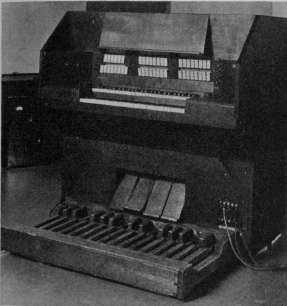
Fig. 10 - Vierling and Kock Organ
Vierling and Kock have recently built an organ at the Heinrich Hertz Institute in Berlin, using many neon tubes in an improved inductive discharge circuit capable of large timbre variation. With this circuit even sine wave currents can be produced. A photograph of their instrument is shown in Fig. 10.
In the Trautonium, commercially produced by the German Telefunken Company, a neon tube with formant circuits is used. A grid-glow tube is used as the variable-frequency generator. Control of the grid potential of this tube is obtained by a long, resistance wire, stretched over a metal plate, and the audio-frequency pitch generated is thus determined by the position along this wire where it is depressed against the plate by a player's finger. By suitable circuit arrangements, the pitch changes of the musical scale may be made linearly related to the frequency changes. Another and separate compressible resistance or other device, under the stiff, spring-mounted plate, varies with the finger pressure on the pitch control wire or tape, and this, in addition to a pedal control, is used to regulate output sound volume. This in-

Fig. 11—The Trautonium, made commercially by the Telefunken Company
of Germany.
strument is most interesting in that it has, like the violin, a very
responsive playing technique. Staccato, legato, glissando, crescendo,
de-cressendo, tremolo, vibrato, and other effects are easily obtained
merely by the method of fingering the pitch wire. Formant circuits
are provided which, like the vocal cavities, produce variations in
the output
timbre. For chordal performance, several of these control wires, each
with its associated generator and timbre-control apparatus may be used,
as in the Mager arrangement. A photograph of the Trautonium is shown
in Fig. 11.
Helberger and Lertes produced another instrument32 with similar playing technique for pitch and amplitude control, that is, a horizontal motion of the finger is used for pitch variation and a vertical motion for amplitude variation. However they use, instead of a grid-elow tube, a feed-back audio-frequency oscillator, pitch-controlled by grid bias, as the generator. The timbre can be varied by filters, formant circuits, and so forth. With several such generator systems having their playing control bands mounted stepwise and close together, as in the Mager multikeyboard plan, harmony may easily be produced. However only one tone at a time can be produced with each band manual.
Mechanicoelectric Instruments
The earliest records I have been able to find on mechanicoelectric musical instruments show E. Lorenz of Germany as the first to suggest them. In 1884 he constructed a crude instrument using the familiar electric-buzzer principle of self-maintained vibrator. These he tuned to the various frequencies of the musical scale. In circuit with the interrupted current he included an electromagnetic telephone for making these interrupted currents audible. The vibrators themselves were placed in an evacuated chamber to eliminate their own air-borne sounds. In 1913 R. Eisemann used a contact type of microphone on a string instrument soundboard34 to feed back currents to driver electromagnets for maintaining string vibration in a mechanicoacoustic instrument.
In 1921, while engaged in electrophonographic research, I used vibration pickup devices on piano and other soundboards, followed by amplifiers and reproducers or recording devices. Later numerous other workers suggested similar arrangements, among them F. C. Hammond, H. Gernsback, E. Hoffman, F. W. Dierdorf, and others.
During the past five years a number of instruments have been produced
wherein the pickup device, instead of being applied to a resonator coupled
to a number of vibrators, is applied directly to the vibrators themselves.
In the Xeo-Bechstein piano, made commercially in Germany, a single
set of magnetic pickups, each serving for several strings, is used. A
keyboard, hammer, and damper action serve to control the string vibration,
while the amplifier and speaker apparatus reproduce the pickup voltages.
A volume control, connected to a piano pedal, regulates volume of sound
output. A set of very soft dampers permits regulation of the damping
rate of the string vibrations. Control of timbre, or additional tone
envelope
control, is not provided.
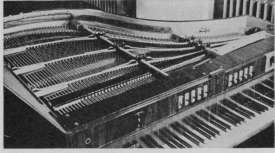
Fig. 12—Internal view of the Vierling-Forster piano.
In the Vierling-Forster Electrochord (Fig. 12) also manufactured commercially in Germany, a generally similar arrangement is used, except that timbre and tone envelope control with electrostatic pickup is provided by the Miessner-Jacobs arrangements.
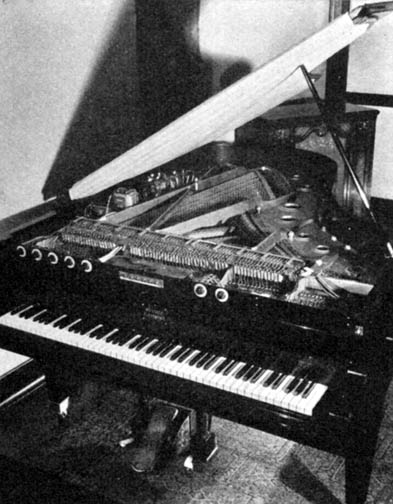
Fig. 13—The Miessner-Jacobs electronic piano.
In the Miessner-Jacobs electronic piano all of the effects obtained with the Electrochord are secured as well as many others. Since this instrument has been rather completely described elsewhere a discussion of it is omitted. A view of it is shown in Fig. 13.
In the Loar Vivitone, tuned steel reeds clamped at one end are plucked by a keyboard action, and thus set into rather rapidly damped vibration with practically no harmonics. Magnetic pickups, with amplifier and reproducer, translate the reed vibrations into sound. A pedal volume control governs loudness.
In the RCA electric carillon, tuned coiled vibrators, somewhat like clock chimes, are set into vibration, and their vibrations, after magnetoelectric translation, are fed to very high power amplifiers and reproducers for outdoor carillons.
A broadcast studio chimes has also been developed by Ranger along these same lines. Its output is fed into the broadcast system for time or other periodic announcements.
Various types of simple string instruments like violins, guitars,
banjos etc, with string vibration pickup, amplification, and reproduction
have appeared on the market in the past year or two, and are being
sold in
considerable numbers.
It gets a little dull here so you might want to skip down to "What now of the Future"
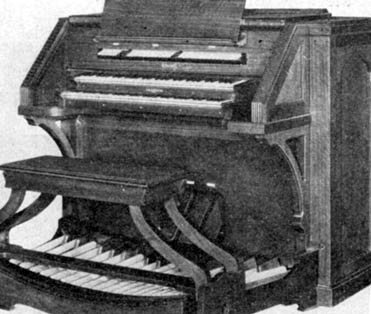
Fig. 14—-Everett Orgatron Model MD-1, using wind-blown Harmonium reeds with electrostatic pickup.
The most recent developments in this country are the electronic organs using wind-blown harmonium reeds. One such, the work of Hoschke, has been placed on the commercial market by the Everett Piano Company. It follows the usual reed and pipe organ design withone bank of reeds for each timbre, and with pneumatic coupling devices for blowing more than one reed with a given key; that is, for introducing octaves, mixtures, and so forth. Electrostatic pickup is used for translating the reed vibrations into alternating voltages which are amplified and reproduced. A larger model, having two manuals and pedal board, has just been announced. This is shown in Fig. 14.
Ranger has developed an instrument utilizing photoelectric transition of wind-blown reed vibration. These reeds operate continuously from an air blower. Small auto lights operated by keyboard furnish light reflected by reeds to the photocell. There are two sets of reeds.
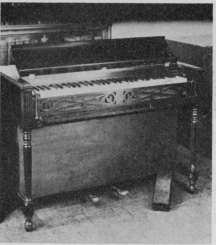
Fig. 15—Miessner electronic organ with single bank of reeds and
single electrostatic pickup.
The writer has developed several instruments with electrostatic translation of wind-blown reeds. Two of these are pictured in Figs. 15 and 16. Of chief interest in these is a new method of timbre control which permits production of numerous timbres from one vibrator. Two or more electrostatic pickup electrodes are mounted near each vibra-tory reed tongue, particularly on its opposite sides in the direction of vibration. Control of the polarities and magnitudes of the charging voltages on these electrodes produces distortions of the translated wave form of the reed motion, so that various electrical wave forms may be produced from a given, fixed, reed-vibration wave form, and thus a considerable range of output harmonic composition is obtained. The effect of wave-form distortion here is not an undesired or disagreeable one, as in sound reproducing equipment, where fidelity to an original is important. Rather its effect, as with formants, is to control the harmonic composition of a given periodically recurring wave form, and its use results in a very effective timbre control.
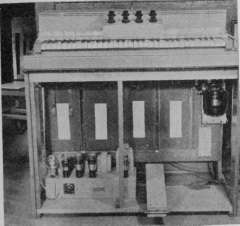
Fig. 16—Miessner electronic organ with four banks of reeds and
dual electrostatic pickup.
In one of these instruments several reeds tuned in harmonic ratios such as first, third, fourth, and fifth are provided for each key of a manual, and these are blown together by the air stream permitted to flow through them when the key is depressed. An internal view of this organ is shown in Fig. 17.
All of these reeds are provided with electrostatic translation pickup electrodes, at least two per reed, front and back. The front electrodes of all fundamental, or first partial, reeds are connected together, and the charging voltage impressed on them is controlled as to sign and magnitude by a potentiometer. The back electrodes are similarly connected, and their voltage simultaneously controlled. Each of the other sets of reeds tuned to harmonic frequencies is similarly arranged. Thus,for one manual, with four reeds per note and two pickups per reed eight timbre controls are provided, in the form of these voltage adjusting potentiometers, unified for given partials of the whole pitch range.
These may be so set as to permit one or all reeds in a note group to be translated or not as desired. Further the translation from each reed may be linear or nonlinear in many variations, and they act in unicon-trol fashion for given partials throughout the keyboard range, so as to maintain uniform timbre throughout that range.
Since, with linear translation adjustment, the output voltage from any reed is concentrated mostly on a few low partials, and with
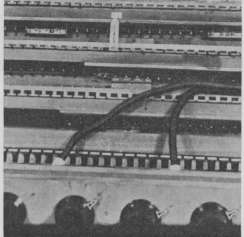
Fig. 17—Interior view of Miessner four-bank reed organ.
nonlinear translation, many harmonics may be introduced,
this plan provides a very large timbre range with very
simple apparatus.
The choice of harmonic
frequencies, to which the several reeds in each note
group are tuned, is determined by the ability of the opposed
pickups for
each reed,
to eliminate easily the fundamental and introduce double
frequencies, or
to leave as much fundamental and add as much second as
is desired. Thus, with our reeds tuned to first, third, fourth,
and fifth,
we can easily
get, by doubling, second, sixth, eighth, and tenth, giving
us a
series including first, second, third, fourth, fifth,
sixth, eighth, and
tenth. Other partials above the fundamental are present
to some extent in
the reed motions, and these appear in the translated
output voltage wave
to extend and enrich its harmonic composition. Harmonics
up to the tenth or fifteenth, having amplitudes greater
than one per cent of the fundamental amplitude, are easily obtained
from a reed by forcing upon it large amplitudes of motion,
with increased
air pressure.
If three pickups are provided for each reed, one at the top, another at the bottom, and a third at the side or end, and all have separately controllable charging voltage of variable amplitude and reversible polarity, the range of harmonic spectra is further extended. In Fig. 18 some of these are shown, all representing different tone qualities, and obtained by a General Radio wave analyzer, from a single reed, always vibrating with the same wave form and amplitude. As shown in No. 17
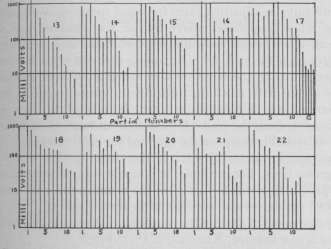
Fig. 18—Some harmonic spectra obtained from"a"single reed (237.5'cycles),
always vibrating the same, using three electrostatic pickups. 13 is for top pickup
alone; 14 is for side pickup alone; 15 is for bottom pickup alone. The others
are for mixtures in aiding or opposing phases and random amplitudes of all three
pickups.
of these spectra, it is possible to obtain harmonics
as high as the twentieth, having amplitudes greater
than a
tenth
of one per
cent
of the strongest
partial present, while those up to the twelfth usually
are within the one per cent amplitude ratio.
The reeds are very simple, cheap, and stable vibrators, easily maintained in vibration by an air stream of very low pressure and yolume; the electrostatic translation devices need only be screws, adjustable in distance, for voicing; the timbre control devices are merely voltage regulating potentiometers, for preselected, or for stop manipu-lated. timbre controls. No complicated timbre circuit wiring, or comlicated key switches are required; the keys merely open air valves, one for each group, of reeds. There are no problems of exact speed control as in rotational generator devices, to avoid frequency drift, or of highly accurate machine work to avoid other undesired rotor or gear effects; the true tempered scale of frequencies, and partials tuned precisely to true harmonic frequencies, present no difficulties. Furthermore, the musically ideal tone envelope is automatically provided by the inability of the reeds to start and stop their vibration abruptly. Last, but very important, is the ability to provide true choir effect timbre mixtures, characteristic of pipe organs, orchestras, or voice groups.
There are, to be sure, some disadvantages with reeds. There is some difficulty in adjusting them for rapid speaking, especially at low pitches, while frequencies above five or six thousand are not very practical. There is also some difficulty, where several reeds are always blown together for each note, in tuning them to exact harmonic frequencies, although the same problem exists to an even greater degree in pipe organs with mixture stops. Again, where complete control of each harmonic is desired, there is a little difficulty in obtaining sine wave outputs from the reeds; for building up tones of numerous separately controllable components, one reed for each component must be used for each fundamental pitch of the organ, so that the number of reeds grows large. For example, in a single manual instrument of 61 notes, providing separate control of ten components, and none higher than 6000 cycles, several hundred reeds are necessary.
My discussion of a few of the significant instruments of the past and of today is now finished. What now of the future?
The ideal instrument is one which can make any sound, known, unknown, or conceivable; to do this we must provide a generator for periodic vibrations embracing the whole audio spectrum of frequencies. We must be able to select from this generator at will any desired single frequency, or many single frequencies simultaneously, whether harmonically or inharmonically related, or whether in narrow or wide continuous bands. We must further be able to emit these frequencies in any desired sound amplitudes and envelope shapes, even though, in a given sound, all the components require different shapes of envelope. We must be able to control the emission of these sounds by some suitable playing technique and apparatus.
With such an apparatus we shall be able to synthesize
any possible sound, continuous, damped, transient,
musical or nonmusical,
for we have all
the elements of sound, and means for putting together
any
desired combination of these elements in any desired
time-amplitude relationship. Looking ahead ten or
twenty years we are now at work on such an instrument.
Additional Selected Bibliography
(1) Thaddeus Cahill, "The Cahill Telharmonium," Elec. World,
(1906).
(2) Clyde J. Fitch, "The piano rad," Radio
News, November, (1926).
(3) G. B. Ashton, "Building the Tromborad," Radio
News, April, (1927).
(4) A. Givelet, "Les instruments de musique a oscillations electriques," Le
Genie Civil, September 22, (1928).
(5) C. T. Hourstj "Les instruments musicaux electriques," Ulngenieur
Cons-tructeur September and October, (1929).
(6) Th. V. Muller, "Radioclavier," Radio
Welt, May 10, (1929).
(7) M. le Lieutenant-Colonel Jullien, "Applications du courant electrique,
des oscillations radioelectriques et des phenomenes photoelectriques
a la realization d'instruments de musique," Conservatoire
National des Arts et Metiers, (1929).
(8) E. Weiss, "Le piano photoelectrique
'Spielman,' n La Nature, July 1, (1930).
(9) E. Weiss, "Un appareil de musique radioelectrique," La
Nature, July 15, (1930).
(10) E. Weiss, "Nouveaux instruments de musique radioelectriques," La
Nature, September, 15, (1930).
(12) "Das Hellertion, ein neues electrisches Musikinstrument," Funkbastler,
July 3, (1931).
(13) E. E. Free, "The electrical future of music," Radio
News, July, (1931).
(14) "Electroakustisches Musikinstrumente und ihre Bauart," Rundfunk
Jahrbuch, (1932).
(15) Oskar Vierling, "Electrische Musik," Electrotech.
Zeit., February 18, (19o2).
(16) Charles A. Culver, "An electrostatic alternator," Physics,
vol. 2, p. 448: June, (1932). ,F '
(17) Oskar Vierling, "Das Electrische Musikinstrumente," Zeit.
des Vereines Deutsches Ingenieure, June 25, (1932).
(18) W. Janovsky, "Electrische Musikinstrumente, ihre Wirkungweise
und Aufgeben," Electrotech. Zeit, July 13,
(1933).
(19) E. M. Sammis, "The Polytone," Radio-Craft,
May, (1934).
21) "WCAU's Photona organ," Electronics,
vol. 8, p. 123; April, (1935).